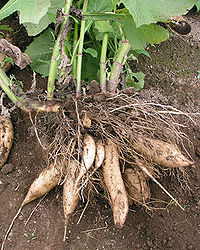
Photo from wikipedia
Yacon is a tuberous root from the Andean region being increasingly grown across the world due to the low caloric values of their roots and the functional properties of extractions… Click to show full abstract
Yacon is a tuberous root from the Andean region being increasingly grown across the world due to the low caloric values of their roots and the functional properties of extractions of its leaves. However, there is still a gap in the knowledge of how the plant develops, and if physical and chemical changes are noticed regarding maturity. The subject of this work was to investigate the dynamics of a group of parameters and to establish correlations across them. To achieve this goal, leaves collected from three different parts of the plant in three months were assessed regarding size (plant height and leaf area), color and the presence of sesquiterpene lactones. Different methods of extraction were also HIGHLIGHTS • Yacon leaves at the apical and middle of the plant present higher phenolic content. • Phenolic content showed correlations with the greenness of the leaves. • The decoction of yacon leaves can extract more phenolics than the infusion. 2 Ferreira, B.M.R.; et al. Brazilian Archives of Biology and Technology. Vol.62: e19180439, 2019 www.scielo.br/babt studied and the total phenolic content was analyzed. The analysis of the results revealed different patterns in the quantity, size and leaf distribution according to the age of the plant. From three different methods of extraction studied, decoction seems to be the most appropriate one to obtain phenolic compounds with greater yield and safety. Besides, the greenness of yacon leaves showed a linear correlation to the total phenolic content, being a simple and promising estimator of the corresponding bioactive group. Sesquiterpene lactones were identified in all extracts, indicating the ease of their extractability even in simple procedures of tea-making.
Journal Title: Brazilian Archives of Biology and Technology
Year Published: 2019
Link to full text (if available)
Share on Social Media: Sign Up to like & get
recommendations!